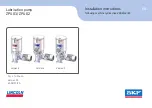
R5
SUPREME - Navigation System
OPERATION FUNCTIONALLITIES
7000 118-383, P11A1
Page 77
RAIM Accuracy Limit
The currently used RAIM accuracy limit used in the RAIM calculations. See chapter 4
“Concepts and Terminology” for more information.
RAIM Status
The current RAIM status result which can be Safe, Unsafe or Caution. The RAIM status is
also indicated by RAIM LED on the front of the R5 SUPREME CDU. A green LED
corresponds to the safe state, yellow to caution state and red to unsafe state.
Correction Source
The currently used correction source for differential correction which can be
Beacon, SBAS,
External
or None (-).
Ref. Station ID
The reference identity of the currently applied differential corrections (if any).
Correction Age
The time difference between navigation solution and reference time for the applied
corrections (if any).
Beacon Tuning
Manual
or
Frequency Scan
. Only displayed when correction source is
Beacon
.
DGNSS warning
A warning that can be shown and which is related to an active DGNSS
Integrity Alert
. The
warnings that can be displayed are:
No Signal
. A correction source for GNSS other than None has been selected in the
GNSS Configuration
view and more than ten seconds have passed since new
differential corrections were applied to the navigation solution.
Station Unhealthy
. Correction source
Beacon
has been selected and the radio beacon
station in use indicates an unhealthy status.
Station Unmonitored
. Correction source
Beacon
has been selected and the radio
beacon station in use indicates an unmonitored status.
Poor signal
. Correction source
Beacon
has been selected and the word error rate of
the received signal in use exceeds 10%.
SBAS Info
The
SBAS Info
view is accessible by
Main Menu
Status
Navigation
GNSS/DGNSS
SBAS info.
The
SBAS Information
view shows information relating to the one or two geostationary SBAS
satellites that the Navigation Sensor is receiving or expecting to receive signals from. Identity
(PRN number) and longitude of the satellite as well as elevation and azimuth angle from the
current position to the satellite and bit error rate of the received signal is provided by the view.
Additionally, when using SBAS as correction source, the satellite used for applied corrections
is also displayed below the list. ‘No SBAS Satellite In Use’ will be displayed if another
correction source than SBAS is selected.
















































